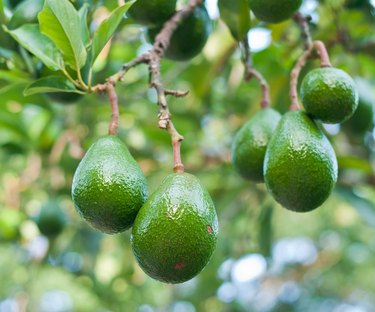
The avocado (Persea americana), a native of Mexico and Central and South America, is prized for its lush, butter-smooth fruits. If you plan to grow avocado trees in the garden, these subtropical and tropical evergreen trees grow as perennials only in U.S. Department of Agriculture plant hardiness zones 9 through 12, depending on the cultivar. If your climate is too cold in winter to grow avocado trees outside, there are dwarf cultivars that you can grow in large containers indoors.
Start With an Avocado Pit
Video of the Day
While named cultivars are available, you can also start your own avocado tree with a pit from an avocado purchased at the grocery store. The resulting tree may take five to 13 years or more to produce fruit. The avocados are unlikely to resemble the parent tree, as many commercially grown avocados are from hybrid trees that are vegetatively reproduced by grafting a scion of the desired cultivar onto healthy rootstock. Seed-grown avocado trees may also bear fruit that's inferior in quality from the original fruit you enjoyed from the market that produced a seed.
Video of the Day
Use an undamaged seed, or pit, from the avocado. Soak it in hot but not boiling water and then remove the outer skin and insert it into a pot filled with moist potting soil. Leave the top one-half to one-third of the pit exposed to the air. Place it in a warm, sunny location and wait for the sprout to appear.
Alternatively, insert three or four toothpicks into the sides of the pit halfway between the bottom and the rounded top. Suspend the pit over a container of water with the bottom half in the water. Change the water every few days until the pit splits and the taproot and sprout appear in two to six weeks. Transplant it into a flower pot; be careful to avoid damaging the roots.
Grow Avocado Trees in Pots
Persea americana 'Little Cado,' also known as the Wurtz avocado, is suitable for growing in large containers or small gardens. At 8 to 12 feet tall, these dwarf trees should be planted at least 8 feet apart if you are growing in a small home orchard and 15 feet away from buildings. If your garden is in USDA zones 8 and below, plant in 18- to 24-inch-wide containers and plan to move your trees indoors for the winter.
Place your avocado tree in a warm, sunny location and keep the soil evenly moist but not waterlogged. Add a 2- to-3-inch layer of mulch over the soil, pulling it back 3 to 4 inches from the tree's trunk. If a soil test indicates the need for fertilizer, use an avocado and citrus fertilizer with added magnesium monthly for the first year and then reduce fertilizing to three or four times annually.
You can give your tree a summer vacation outside but acclimate it by placing it in dappled shade for a week or two before moving it into full sunlight. Monitor the soil moisture closely. Dolly it back into a warm sunroom or greenhouse in fall before frost threatens.
Grow Avocado Trees Outside
Plant dwarf or full-size avocado trees in a well-drained, full-sun location. Full-size trees should be planted at least 20 feet from structures, as they can grow 40 feet tall or more. Dig the planting hole three to four times as wide and only as deep as the tree's root ball. Add soil back to the hole until the tree is at the same level as it was in the grower's pot and then backfill with unamended soil.
Tamp lightly and then water thoroughly. Continue watering every other day for the first week and then reduce watering to once or twice a week as the tree becomes established in the garden. Stop watering during the rainy season unless there is a dry spell, in which case water weekly until the rain resumes. Protect young trees from frosty nights with frost blankets or plastic sheeting suspended on bamboo poles. Anchor the covering to the ground with rocks, bricks or boards.
If soil-test results recommend fertilizer, fertilize with a balanced fertilizer augmented with magnesium monthly for the first year and then reduce fertilizing to three or four times a year as the young tree grows. Put on safety goggles, gloves and other safety gear and then prune and shape the tree with pruners sterilized in rubbing alcohol. Even large cultivars like Persea americana 'Bacon,' 'Fuerte' and 'Hass' can be maintained at 10 to 20 feet tall with regular pruning.
Flowers and Fruits
Avocado trees are generally self-fertile but produce better with a second tree nearby. The trees are classed by their flowers: "A"-type flowers open as female in the morning, close and open again the next afternoon as male flowers, while "B"-type flowers open as female in the afternoon, close and open the following morning as male flowers. The flowers open when air temperatures are above 70 degrees Fahrenheit.
The fruits take several months to ripen. Snip the stem of a large avocado while it is still hard and let it soften on the kitchen counter for three to eight days. If the fruit shrivels or starts to rot, the avocados aren't ready to harvest. You can leave them on the tree until you're ready to harvest the fruits, but eventually, they will fall off the branches.